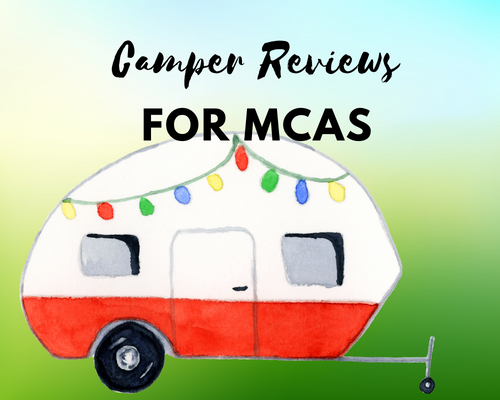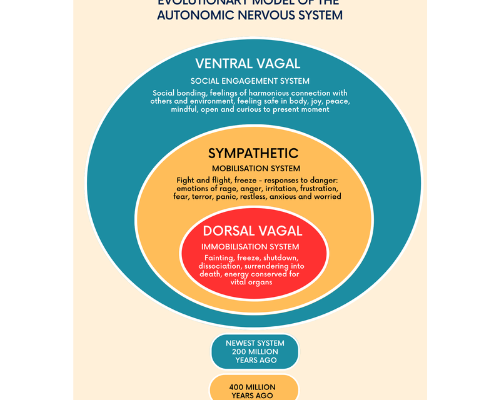Here are my top 3 campers for those with MCAS or other chronic illness.
Like many people, during Covid-19 I wanted to get out and experience nature as a way to vacation without the risks of human contact. Sales of campers boomed, campsites were full, and vlogs about van life and car life exploded. Self-contained alternatives for vacationing like travel trailers and vans appeal to me with my Mast Cell Activation Syndrome (MCAS) diagnosis since I can’t tolerate hotels due to off-gassing building materials, mold, and the standard use of cleaning and laundry chemicals.
As an Amazon Associate, I earn from qualifying purchases.
Table of Contents
What is MCAS?
Mast Cell Activation Syndrome (MCAS) is a chronic condition that affects all organ systems. MCAS is serious and disabling and people with MCAS experience often significant and debilitating symptoms daily, including anaphylaxis, which can be fatal.
MCAS is often found in combination with other chronic conditions such as Ehlers-Danlos Syndrome (EDS) and Postural Orthostatic Tachycardia Syndrome (POTS).
Frequently healthcare providers do not know about MCAS, and the tests for MCAS are problematic because they are not uniformly reliable. MCAS can be difficult to manage. Treatments include blocking mast cell mediators with anti-histamines and mast cell stabilizers, as well as avoiding triggers.
Check out this post on how to manage MCAS.
What are the options for campers for those with MCAS?
Tent camping is an option, but the chemicals in tent materials may trigger those with Multiple Chemical Sensitivities (MCS). Tents can also be problematic for those with mold sensitivities, and if you have chronic pain then sleeping in a tent outside might not be an option due to physical limitations and discomfort.
https://www.pinterest.com/pin/1054475700229257523/You can rent a camper or travel trailer, but those with MCAS often can’t tolerate the mold and VOCs that are common in many campers. Plus the cleaning products used to clean and sanitize rental campers between use are problematic for those with MCAS. So, what are the options specifically for those with MCAS?
Go with a building biologist’s recommendations
I follow Corinne Segura, a building biologist whose blog My Chemical-Free House contains a wealth of information on safe building materials for homes (and campers). Segura has blogged extensively on how to build out a cargo van safely, tiny homes and campers for those with multiple chemical sensitivities, and many other helpful topics relating to living safely and more comfortably with MCS. I include many of her notes and links below. Based on Segura’s recommendations and my own research I came up with three travel trailers worth comparing for those with MCAS.
Convenience for chronic illness
Having a complex chronic illness affects everything about camping. But camping is so worth it to get away from civilization, and pollution, and to connect with nature.
Some of the things that I looked at when comparing travel trailers were ease of use for those with chronic illness (fatigue and mobility issues); ease of food preparation and medication storage; having power for medical devices; being as free as possible from toxins and EMFs, and overall physical comfort.
Metal vs. fiberglass shells
The appeal of a converted cargo van is huge, especially for people with multiple chemical sensitivities looking to escape a toxic home environment. One big problem is that a metal van with people inside it will accumulate condensation someplace within due to the temperature differential between the outside and inside environment. All it takes to grow mold is moisture and a fuel source. And anywhere you have condensation, or moisture, from cooking, showering, and even respiration, you are going to run the risk of mold growth.
This situation isn’t unique to vans but is common in all kinds of campers, especially those that have metal shells. Porous materials such as carpeting on the floors or walls, cushions, mattresses, clothing, and linens can serve as fuel for mold growth. Even if the carpeting or textiles are vinyl and therefore not going to grow mold, the glues, foams, and adhesives that are used to insulate and affix the interior materials, are also possible fuel sources for mold, as well as sleeping mattresses, pillows, and bedding.
A fiberglass shell camper or travel trailer is still going to accumulate condensation but to a lesser extent than a metal shell option such as a cargo van or airstream. Segura’s post says, that the camper designs that are best for mold are either
Sandwich construction – Airtight cavities of metal or fiberglass with rigid foam insulation. Ideally laminated together.
Fiberglass shells – A Solid fiberglass body that can either have single or double hulls. A single hull has no cavity for condensation or mold to form. A double hull can work well too if it is completely sealed and moisture cannot get between the layers.
Off-gassing of campers for those with MCAS
All new campers and travel trailers will off-gas construction materials to some extent. Choosing materials that are less likely to off-gas Volatile Organic Compounds (VOCs) is the key to managing this variable. For instance:
- choose flooring and window treatments that are not vinyl
- minimize the use of glues
- choose formaldehyde-free wood, or seal wood and other materials with shellac or paint to stop off-gassing from continuing after installation
When I inquired about the option for a lower VOC option, I learned that the Happier Camper HC1 can be customized with either bamboo or unfinished wood tabletops and cabinetry. You would need to ask for unfinished wood specifically. I was impressed that the owner offered a beeswax finish alternative because he didn’t want the wood to become damaged. But I’ve heard that the cushions in the HC1 can also be a source of off-gassing.
Flooring
Careful consideration of flooring materials is key to avoiding toxic off-gassing and potential mold growth. Segura created this informative post on choosing non-toxic flooring options for campers. And Segura reviews non-toxic rugs in this post.
My choice in the camper comparison below, The Happier Camper HC1, comes with modular plastic floor tiles with a nylon “rug” material glued to each floor square. The rug material is not going to grow mold or have significant off-gassing toxicity by itself, but the glue could be irritating for some and a potential fuel source for mold. I spoke with the HC1 manufacturer who was willing to offer the floor squares without the “rug” squares glued on, thereby eliminating the issue with the glue.
Keeping warm in campers for those with MCAS
Options for warmth in travel trailers and campers are propane heaters, electric heaters, electric blankets, and heated biomats for sleeping. Healthy Wave uses an advanced filtration system and extra EMF-blocking layers to make sure the user isn’t exposed to unhealthy EMFs while obtaining the benefits of red light, negative ions, crystal therapy, and PEMF (in certain units). Because of my MCAS, I am especially sensitive to EMFs, yet I recognize the benefits of far infrared heat and PEMFs.
I’m personally not comfortable with propane heat inside a camper because there is always a danger of carbon monoxide poisoning when using propane heaters indoors, and the potential to trigger my mast cell activation symptoms.
Segura recommends this electric heater for campers. I like this one because it has a thermostat for protection against overheating. I also like the idea of using a heated biomat under the mattress that is low in EMFs. That way you concentrate the heat where you need it while sleeping.
One of my mast cell activation triggers is being too cold, so for me, it is worth it to have some form of heat in a camper. Plus, heating extends the usable window for the camper to three seasons.
EMFs in campers for those with MCAS
The biggest problem I have with metal vans or trailers is that the metal acts as a container for Electromagnetic Frequencies (EMFs). EMFs are emitted from Bluetooth devices, from your cell phone signal and from cell phone towers trying to communicate with your phone and laptop, from microwave radiation coming from microwave ovens, and countless other sources.
In a metal camper, the EMFs bounce off the walls, thereby creating a reverse faraday cage. Those with chronic illnesses, and anyone with a concern about EMFs, want to be shielded from EMFs, especially when they are sleeping. In a metal camper the EMFs present bounce off the metal sides and aren’t able to escape, thereby greatly increasing your exposure.
I prefer a fiberglass unit for this reason, though you will still need to shield yourself from EMFs originating from your phone (or turn off your phone) and from EMFs coming from sources outside your camper, for instance from cell phone signal extenders at campgrounds. One way to do this is with a bed canopy.
I discuss EMFs in further detail here and here.
Do you know your typical symptom progression?
One of the keys to understanding the level of your bucket is knowing your symptom progression. It is helpful to keep track of the symptoms you are having and to evaluate whether they are escalating. Symptom escalation means that the level of your bucket is rising.
Knowing your symptom progression in a symptom flare is the key to developing your own rescue plan. In this post, I discuss how to determine your own symptom progression. Once you know what typically happens in your symptom progression you can design a rescue plan to address those symptoms.
Get my free ebook, symptom log, and meal plan!
Want a tool to keep track of your symptoms easily? Sign up for my newsletter and you will receive my free 50-page ebook of lower-histamine, grain-free, sugar-free recipes, my free symptom log, and a free two-week meal plan!
Power in campers for those with MCAS
Having the ability to power your devices, charge your phone, and run a fan is key to comfort in a camper. But it’s important to bear in mind the EMFs, dirty electricity, and magnetic fields produced by solar panels and inverters, and to choose wisely.
One option is to use a portable power station such as the Jackery, which can be charged with either a portable solar panel or with shore power. Jackery makes many different models with varying capacities. I originally purchased the Jackery 160 which has just enough juice to power a USB fan and charge up my phone for about three nights. To run a medical device like a CPAP you will want more wattage in a power source, like the Jackery 500. By using a portable power station you can keep the dirty electricity and magnetic fields further away from your body by charging at a distance and making sure to use the device as far away from your body as your cords allow.
Another option is electrical wiring shielded with metal conduit such as this cabling. If you purchase a camper used or already wired you will not have this option. When I spoke with Happier Camper about the possibility of using shielded conduit in the wiring they told me that it wasn’t possible with their design because it would compromise the integrity of the fiberglass. But one workaround is to install a main kill switch for the electrical power in an HC1 so that you can turn all of your electrical off before bed, and know that you are not being exposed to dirty electricity while you sleep. Or just flip off the electrical panel at bedtime.
Keeping cool in campers for those with MCAS
Many high-end camper models include air conditioning, and if heat is a trigger for your mast cell activation, then it might be worth it to splurge to keep cool. For the Happier Camper HC1 which I profile below, you can add AC for about $1700. Another option for any camp setup is to purchase the Zero Breeze portable air conditioner for between $1000-$2100, depending on the wattage. Another option is the Ecoflow portable air conditioner for about $1200. You can save money on the initial camper purchase by opting to add a portable unit later, but keep in mind that you will need to be able to vent it out a window or other opening to the outside.
The trade-off with having air conditioning is that you will be exposed to magnetic fields and potentially dirty electricity as well. By using AC judiciously to cool down your camper before bed, and/or using AC on a timer you can limit your exposure while benefitting from the cool air.
Bathrooms in campers for those with MCAS
Having a separate bathroom space is nice for privacy, but if you are used to dry camping or do most of your camping solo, it’s not as big of an issue.
Keeping moisture out of the camper is a key reason to avoid having a shower in a camper or camp trailer. There are many easy-to-use camp shower options available like this one that can be set up in a portable pop-up shower enclosure outside. You can also use this type of enclosure as an outdoor bathroom enclosure for the toilet. Segura discusses composting toilets in this post. My favorite toilet option is the bucket and bag for many reasons: it’s super low-tech, cheap, not fixed (can be moved), and easy to dump.
Cooking in campers for those with MCAS
A general rule for mold control is to avoid cooking and showering in a camper. When you are used to car camping it is standard to set up your camp stove outside on a picnic table or camp table. Some campers and travel trailers offer full kitchens as a major selling point, and that is definitely convenient for making meals that fit your MCAS dietary restrictions. But for keeping your camp unit mold-safe it’s best to avoid cooking indoors.
As I discussed in this post, I like this solar oven, and I you can purchase my version here for $20. I love this camp stove because it’s super light and portable, it’s easy to find replacement fuel canisters, and it packs very small.
Unless you plan to refill your cooler with ice regularly, it is nice to have an electric cooler or RV refrigerator. This model can run on either a battery or solar. Dometic also makes this nice electric fridge. Having reliably cold food is key with MCAS because I need to either eat food cooked fresh or foods heated up directly from the freezer. This is because histamine readily accumulates in leftovers.
Travel trailer comparison
If you are looking to convert a cargo van then this blog by Segura is a great starting place. As I discussed above, being in a metal-free unit is important to me, so that eliminates cargo vans from my comparison. I also am more interested in a travel trailer than a camper because it offers more flexibility to park the trailer while still being able to use the tow vehicle for transportation.
When I looked at all of the features that were important to me in a travel trailer I narrowed it down to three units:
Hero Ranger
- 16 ft long / >2000 lb
- Approximately $29K
- Teardrop with outdoor kitchen, roof rack
Segura says it’s, “… the most ideal design. The walls, floor, and ceiling are all a sandwich construction (laminated) just like the old Camplites, except those didn’t have insulated floors. I was really excited to find this one. The envelope is constructed of fiberglass (on the outside)-foam-metal. Perfect. The best construction for mold prevention. The interior is metal which is great for those with chemical sensitivities, though keep in mind all new trailers have off-gassing from the construction adhesives. It has a small kitchen on the exterior, two options for heater types, and no bathroom. This is a European company.”
Pros of this unit are price and attention to construction for mold prevention.
Cons of this unit are the length and weight, and the fact that it has a layer of metal in the construction (not good for EMFs)
Safari Caravans Alto F1743
- 1700 lb
- $48K CAD
Segura says it’s, “another great option to consider. A bit of a hidden gem, this one. The roof and walls are made of a “sandwich-type material with a plastic honeycomb core laminated with Alufiber on one side and aluminum on the other. That main core is not foam or fiberglass insulation, it’s a honeycomb polypropylene. Alufiber is an aluminum and fiberglass product. This sounds like a very moisture-proof design to me. They say the only materials used in the Alto body are aluminum, Alufiber, plastic, Formica, and glass. The furniture is mostly made of aluminum and composite materials. They need a fair amount of time to off-gas for most sensitive people, though some less sensitive have used them brand new. I have heard from one person who found this trailer to be higher in off-gassing than most other trailers.”
Pros of this unit are the design is moisture-proof, and they are quite stylish and comfortable.
Cons of this unit are cost, it is more difficult to find in the US, it also has a metal layer and the potential for greater off-gassing issues.
Happier Camper HC1
- 13 feet / 1100 lb.
- ~ $50,000 USD can include awning, solar, stabilizers
Segura says, “No carpet or padding on the walls, and the floors are fiberglass; No vinyl on the floors is a rare find and will be preferable for many folks. It’s a double hull with Thinsulate in between the hulls. The floors are composed of plastic honeycomb integrated with corrugated cardboard and fiberglass resin.”
Pros of this unit are the HC1 comes with a modular interior design, meaning that you can customize how you want the inside, and change it up whenever you want. For instance, HC1 offers a toilet module, a sink module with fresh and greywater disposal tanks, and different sizes of modular storage cubes depending on your storage needs. You can design the unit to have an integrated set of bunkbeds or have the option for a queen or twin-sized bed, depending on the configuration of the storage cubes. You can even take everything out of the HC1 to easily clean it (even hose it out!) and use it to haul larger items.
The HC1 with an optional propane heater, an optional “lifted” option for more comfort off-road, and off-grid options with solar, batteries, and an inverter, to run your electronics and electric heat if desired.
Cons of the HC1 are the potential for dirty electric and magnetic fields because the wiring is unshielded (but it’s the same for the Safari and Hero Ranger). A number of people on HC1 Facebook groups also mentioned that the cushions off-gas significantly in the beginning, so allowing adequate lead-time to allow for off-gassing before using the unit is important.
Conclusion
I visited a showroom and did lots of research about these three travel trailers, and here are my conclusions. I liked the HC1 the best because it was the lightest unit, and I could conceivably hook it up to my Subaru Forester and maneuver it myself. I’ve camped in my car many times without adequate headspace so I was excited about the prospect of being able to stand up to prepare food and medications in the HC1. I was impressed in speaking with the Happier Camper sales agent that they were willing to work with me to make the HC1 compatible with many of my sensitivities, including selling me the floor tiles without carpet, and unfinished wooden tabletops and cabinetry so that I could apply my own non-toxic wood finish. I especially like the modular design that makes it easy to reconfigure the unit for one or two people, with – or without – the kitchen and toilet modules. I could do yoga in the HC1 with the available floor space even after the queen size bed is installed.
Sign up for the SSP!
The Safe and Sound Protocol (SSP) is a listening therapy based on Polyvagal Theory that helps heal nervous system regulation. Many people with MCAS have nervous system dysregulation stemming from infections, toxic exposures, concussions, and trauma. The SSP is an easy-to-use app where you listen to specially filtered music for 30 minutes each day for a 5-hour cycle. Studies show the SSP has a profound effect on mental health and chronic conditions
You can sign up for the SSP here!
Order my book!
Rocks and Roots chronicles my journey solo backpacking the Superior Hiking Trail and overcoming nervous system dysregulation, gut dysbiosis, and Mast Cell Activation Syndrome symptoms to hike 328 miles successfully.
Check out this powerful frequency device
Healy is an individualized microcurrent device I use to reduce inflammation. Check out this post for more about Healy.
Sign up for a session!
I provide one-on-one in-person and remote chronic illness and caregiver coaching and Sacred Self-Healing Sessions based on the Sacred Self-Healing Method, a proven novel co-creative healing modality detailed in my Books.
Click here for more information.
What do you think?
I’d love to have your reply below!
Disclaimer
The preceding material does not constitute medical advice. This information is for information purposes only and is not intended to be a substitute for professional medical advice, diagnosis, cure or treatment. Always seek advice from your medical doctor.






